Exploring the Vegetation Changes in Poyang Lake Wetlands: Succession and Key Drivers over Past 30 Years
Abstract
:1. Introduction
2. Materials and Methods
2.1. Study Area and Data
2.1.1. Remote Sensing Data
2.1.2. Meteorological and Hydrological Data
2.2. Methods
2.2.1. Water Area Extraction
2.2.2. Calculation of FVC
2.2.3. Classification of Land Use Types
2.2.4. Statistical Analysis
3. Results
3.1. Spatial and Temporal Characteristics of Water Area
3.2. Spatial and Temporal Characteristics of FVC
3.3. Evolution Patterns of Land Use Types
3.3.1. Spatial Distribution
3.3.2. Interannual Variation
3.3.3. Shifts in Land Use Types
3.4. Analysis of Influencing Factors
4. Discussion
4.1. Comparative Analysis of Water Area
4.2. Influencing Factors of Wetland Evolution
5. Conclusions
Author Contributions
Funding
Data Availability Statement
Conflicts of Interest
Abbreviations
| FVC | Fractional vegetation cover |
| NDVI | Normalized difference vegetation index |
| NDWI | Normalized difference water index |
| MNDWI | Modified normalized difference water index |
| EVI | Enhanced vegetation index |
| RFSC | Random forest supervised classification |
References
- Wang, R.Q.; Zhang, M.X.; Wu, H.T.; Li, Y.H. Analysis on Wetland Definition and Classification of the Wetland Conservation Law of the People’s Republic of China. Wetl. Sci. 2022, 20, 404–412. [Google Scholar]
- Zhao, T.G.; Yu, R.H.; Zhang, Z.L.; Bai, X.S.; Zeng, Q.A. Estimation of wetland vegetation aboveground biomass based on remote sensing data: A review. Chin. J. Ecol. 2016, 35, 1936–1946. (In Chinese) [Google Scholar]
- Davidson, N. How much wetland has the world lost? Long-term and recent trends in global wetland area. Mar. Freshw. Res 2014, 65, 936–941. [Google Scholar] [CrossRef]
- Courouble, M.; Davidson, N.; Dinesen, L.; Fennessy, S.; Galewski, T.; Guelmami, R.; Kumar, R.; McInnes, R.; Perennou, C.; Rebelo, L.M.; et al. Convention on Wetlands. In Secretariat of the Convention on Wetlands; Global Wetland Outlook: Gland, Switzerland, 2021. [Google Scholar]
- Yan, X.; Wang, R.; Niu, Z. Response of China’s Wetland NDVI to Climate Changes. Wetlands 2022, 42, 55. [Google Scholar] [CrossRef]
- Chen, L.G.; Chen, L.M.; Xu, Y.F.; Luan, Z.Y.; Jin, Q.; Shi, Y.; Hu, T.F. Effects of water level fluctuation on the potential habitat area of Vallisneria natans in Poyang Lake. Adv. Water Sci. 2020, 31, 377–384. (In Chinese) [Google Scholar]
- Huang, H.X. Vegetation Succession Analysis of Poyang Lake Water-Land Ecotone Based on Gaofen-1 Satellite Image. Jiangxi Sci. 2019, 37, 335–340, 427. (In Chinese) [Google Scholar]
- Lin, Y.L.; Li, X.H.; Tan, Z.Q.; Song, Y.Y.; Xu, C.Y. Dynamic characteristics of vegetation communities in the floodplain wetland of Lake Poyang based on spatio-temporal fusion of remote sensing data. J. Lake Sci. 2023, 35, 1408–1423. [Google Scholar]
- Yang, X.X. Impacts of Climate Change and Human Activities on the Terrestrial Vegetation Cover Changes in the Poyang Lake Basin. Master’s Thesis, Southwest University, Chongqing, China, 2022. (In Chinese). [Google Scholar]
- Kreyling, J.; Tanneberger, F.; Jansen, F.; van der Linden, S.; Aggenbach, C.; Blüml, V.; Couwenberg, J.; Emsens, W.; Joosten, H.; Klimkowska, A.; et al. Rewetting Does Not Return Drained Fen Peatlands to Their Old Selves. Nat. Commun. 2021, 12, 5693. [Google Scholar] [CrossRef]
- Song, Y.; Zhang, Q.; Jiang, S.; Guo, Y. Groundwater Depth and Its Relation with Typical Vegetation Distribution in the Poyang Lake Wetland, China. J. Appl. Ecol. 2021, 32, 123–133. [Google Scholar]
- Sun, L.; Han, Z.; Wang, S.; Wang, J.; Liu, X.; Wang, J. Simulation of Wetland Vegetation Succession Based on Coupled Gaussian and Population Dynamics Models: A Case Study of Poyang Lake Wetlands. Watershed Ecol. Environ. 2025, 7, 1–10. [Google Scholar] [CrossRef]
- Ashok, A.; Rani, H.P.; Jayakumar, K.V. Monitoring of Dynamic Wetland Changes Using NDVI and NDWI Based Landsat Imagery. Remote Sens. Appl. Soc. Environ. 2021, 23, 100547. [Google Scholar] [CrossRef]
- Long, X.; Lin, H.; An, X.; Chen, S.; Qi, S.; Zhang, M. Evaluation and analysis of ecosystem service value based on land use/cover change in Dongting Lake wetland. Ecol. Indic 2022, 136, 108619. [Google Scholar] [CrossRef]
- Peng, H.; Xia, H.; Shi, Q.; Chen, H.; Chu, N.; Liang, J.; Gao, Z. Monitoring spatial and temporal dynamics of wetland vegetation and their response to hydrological conditions in a large seasonal lake with time series Landsat data. Ecol. Indic. 2022, 142, 109283. [Google Scholar] [CrossRef]
- Zhang, M.; Lin, H.; Long, X.; Cai, Y. Analyzing the spatiotemporal pattern and driving factors of wetland vegetation changes using 2000–2019 time-series Landsat data. Sci. Total Environ. 2021, 780, 146615. [Google Scholar] [CrossRef]
- Cano, D.; Pizarro, S.; Cacciuttolo, C.; Peñaloza, R.; Yaranga, R.; Gandini, M.L. Study of Ecosystem Degradation Dynamics in the Peruvian Highlands: Landsat Time-Series Trend Analysis (1985–2022) with ARVI for Different Vegetation Cover Types. Sustainability 2023, 15, 15472. [Google Scholar] [CrossRef]
- Feng, D.; Fu, M.; Sun, Y.; Bao, W.; Zhang, M.; Zhang, Y.; Wu, J. How Large-Scale Anthropogenic Activities Influence Vegetation Cover Change in China? A Review. Forests 2021, 12, 320. [Google Scholar] [CrossRef]
- Li, C.; Jia, X.; Zhu, R.; Mei, X.; Wang, D.; Zhang, X. Seasonal Spatiotemporal Changes in the NDVI and Its Driving Forces in Wuliangsu Lake Basin, Northern China from 1990 to 2020. Remote Sens 2023, 15, 2965. [Google Scholar] [CrossRef]
- Liu, M.; Hamilton, S.H.; Jakeman, A.J.; Lerat, J.; Savage, C.; Croke, B.F.W. Assessing the contribution of hydrologic and climatic factors on vegetation condition changes in semi-arid wetlands: An analysis for the Narran Lakes. Ecol. Model. 2024, 487, 110568. [Google Scholar] [CrossRef]
- Huang, A.; Liu, X.; Peng, W.; Dong, F.; Han, Z.; Du, F.; Ma, B.; Wang, W. Spatiotemporal heterogeneity of inundation pattern of floodplain lake wetlands and impact on wetland vegetation. Sci. Total Environ. 2023, 905, 167831. [Google Scholar] [CrossRef]
- Bornette, G.; Henriot, C.P.; Arthaud, F. Effects of a decennial spate flood on substrate and aquatic vegetation of riverine wetlands. Aquat. Bot. 2024, 194, 103789. [Google Scholar] [CrossRef]
- Xu, L.G.; Xie, Y.H.; Wang, X.L. Ecological Environment Problems and Research Prospect of Flood Wetlands of Yangtze River-connected Lake in the Middle Reaches of Yangtze River. Bull. Natl. Nat. Sci. Found. China 2022, 36, 406–411. (In Chinese) [Google Scholar]
- Ivajnsic, D.; Sajna, N.; Kaligaric, M. Primary Succession on Re-Created Coastal Wetland Leads to Successful Restoration of Coastal Halophyte Vegetation. Landsc. Urban Plan 2016, 150, 79–86. [Google Scholar] [CrossRef]
- Lei, S.; Zhang, X.P.; Li, R.F.; Xu, X.H.; Fu, Q. Analysis the changes of annual for Poyang Lake wetland vegetation based on MODIS monitoring. Procedia Environ. Sci. 2011, 10, 1841–1846. [Google Scholar]
- Li, R.; Liu, J. Estimating wetland vegetation biomass in the Poyang Lake of central China from Landsat ETM data. IGARSS 2004. In Proceedings of the 2004 IEEE International Geoscience and Remote Sensing Symposium, Anchorage, AK, USA, 20–24 September 2004; Volume 7, pp. 4590–4593. [Google Scholar]
- Proisy, C.; Couteron, P.; Fromard, F. Predicting and mapping mangrove biomass from canopy grain analysis using Fourier-based textural ordination of IKONOS images. Remote Sens. Env. 2007, 109, 379–392. [Google Scholar] [CrossRef]
- Na, X.D.; Zang, S.Y.; Zhang, N.N.; Cui, J. Impact of land use and land cover dynamics on Zhalong wetland reserve ecosystem, Heilongjiang Province, China. Int. J. Environ. Sci. Technol. 2015, 12, 445–454. [Google Scholar] [CrossRef]
- Du, Y.; Xue, H.; Wu, S.; Ling, F.; Xiao, F.; Wei, X. Lake area changes in the middle Yangtze region of China over the 20th century. J. Environ. Manage. 2011, 92, 1248–1255. [Google Scholar] [CrossRef]
- Chen, H.F.; Wang, J.L.; Chen, Z.; Yang, L.; Xi, W.J. Comparison of Water Extraction Methods in Mountainous Plateau Region from TM Image. Remote Sens. Technol. Appl. 2004, 19, 479–484. (In Chinese) [Google Scholar]
- Wang, L.; Xie, H.B.; Wen, G.C.; Yang, Y.H. A study on water information extraction method of cyanobacteria lake based on Landsat8. Remote Sens. Land Resour. 2020, 32, 130–136. (In Chinese) [Google Scholar]
- Zhang, C.; Kuai, S.Y.; Tang, C.H.; Zhang, S.H. Evaluation of hydrological connectivity in a river floodplain system and its influence on the vegetation coverage. Ecol. Indic. 2022, 144, 109445. [Google Scholar] [CrossRef]
- McFeeters, S.K. The use of the Normalized Difference Water Index (NDWI) in the delineation of open water features. Int. J. Remote Sens. 1996, 17, 1425–1432. [Google Scholar] [CrossRef]
- Ouma, Y.O.; Tateishi, R. A water index for rapid mapping of shoreline changes of five East African Rift Valley lakes: An empirical analysis using Landsat TM and ETM+ data. Int. J. Remote Sens. 2006, 27, 3153–3181. [Google Scholar] [CrossRef]
- Du, Y.; Zhang, Y.; Ling, F.; Wang, Q.; Li, W.; Li, X. Water Bodies’ Mapping from Sentinel-2 Imagery with Modified Normalized Difference Water Index at 10-m Spatial Resolution Produced by Sharpening the SWIR Band. Remote Sens. 2016, 8, 354. [Google Scholar] [CrossRef]
- Wang, Q.M.; Zhang, Y.; Dou, P.; Zhao, Y.; Li, E.C.; Ma, M.Y. Evolution law of water surface area in the Beijing-Tianjin-Hebei plain from 1985 to 2020. J. Hydraul. Eng. 2023, 54, 451–460. [Google Scholar]
- Lu, D.; Weng, Q. A survey of image classification methods and techniques for improving classification performance. Int. J. Remote Sens. 2007, 28, 823–870. [Google Scholar] [CrossRef]
- Qiu, M.; Liu, Y.; Chen, P.; He, N.; Wang, S.; Huang, X.; Fu, B. Spatio-temporal changes and hydrological forces of wetland landscape pattern in the Yellow River Delta during 1986–2022. Landsc. Ecol. 2024, 39, 51. [Google Scholar] [CrossRef]
- Liu, Y. Remote Sensing Estimation of Dominant Plant Community Biomass at Poyang Lake Wetland. Master’s Thesis, Jiangxi Normal University, Nanchang, China, 2023. [Google Scholar]
- Gao, J.F.; Cao, J.Y.; Dong, C. Research on Land Cover Classification Algorithm Based on Time Series Data. Geomat. Spat. Inf. Technol. 2022, 45, 73–75, 79. [Google Scholar]
- Mao, D.H.; Wang, Z.M.; Jia, M.M.; Luo, L.; Niu, Z.G.; Jiang, W.G.; Sun, W.W. Overview of global wetland remote sensing research: 1975–2020. J. Remote Sens. 2023, 27, 1270–1280. (In Chinese) [Google Scholar]
- Yao, S.M.; Hu, C.W.; Qu, G.; Chai, Z.H.; Luan, H.L. Research Advances in Morphological Evolution of Lakes Connecting the Yangtze River and Its Influences. J. Yangtze River Sci. Res. Inst. 2022, 39, 15–23. (In Chinese) [Google Scholar]
- Zhang, C.; Zhen, H.; Zhang, S.; Tang, C. Dynamic changes in net primary productivity of marsh wetland vegetation in China from 2005 to 2015. Ecol. Indic. 2023, 155, 110970. [Google Scholar] [CrossRef]
- Shen, Y.; Cheng, J.; Xu, L.; Li, R.; You, H.; Yang, H. Characteristics of zooplankton community structure in Poyang Lake and their influencing factors under extreme hydrological drought. Acta Ecologica Sinica. 2023, 43, 10399–10412. (In Chinese) [Google Scholar]
- Hu, Z.P. Serious drought in Poyang Lake in 2022 and countermeasures for drought prevention and disaster reduction. China Flood Drought Manag. 2023, 33, 1–6+39. (In Chinese) [Google Scholar]
- Zhang, X.; Liu, L.; Zhao, T.; Chen, X.; Lin, S.; Wang, J.; Mi, J.; Liu, W. GWL_FCS30: A global 30 m wetland map with a fine classification system using multi-sourced and time-series remote sensing imagery in 2020. Earth Syst. Sci. Data. 2023, 15, 265–293. [Google Scholar] [CrossRef]
- Qi, Y.N.; Dou, H.T.; Li, H.P.; Wang, W.J. Dynamic change of water surface area in Baiyangdian by MNDWI. In Proceedings of the 2021 2nd International Conference on Big Data & Artificial Intelligence & Software Engineering (ICBASE), Zhuhai, China, 24–26 September 2021; pp. 317–351. [Google Scholar]
- Tian, B.Q.; Gao, P.; Mu, X.M.; Zhao, G.J. Water Area Variation and River–Lake Interactions in the Poyang Lake from 1977–2021. Remote Sens. 2023, 15, 600. [Google Scholar] [CrossRef]
- Xu, H.Q. Modification of normalised difference water index (NDWI) to enhance open water features in remotely sensed imagery. Int. J. Remote Sens. 2006, 27, 3025–3033. [Google Scholar] [CrossRef]
- Hu, Z.P.; Lin, Y.R. Analysis of Evolution Process and Driving Factors for Aquatic Vegetations of Poyang Lake in 30 Years. Resour. Environ. Yangtze Basin 2019, 28, 1947–1955. [Google Scholar]
- You, H.; Fan, H.; Xu, L.; Wu, Y.; Wang, X.; Liu, L.; Yao, Z.; Yan, B. Effects of Water Regime on Spring Wetland Landscape Evolution in Poyang Lake between 2000 and 2010. Water 2017, 9, 467. [Google Scholar] [CrossRef]
- Liu, Z.; Han, Y.; Zhu, R.; Qu, C.; Zhang, P.; Xu, Y.; Zhang, J.; Zhuang, L.; Wang, F.; Huang, F. Spatio-Temporal Land-Use/Cover Change Dynamics Using Spatiotemporal Data Fusion Model and Google Earth Engine in Jilin Province, China. Land 2024, 13, 924. [Google Scholar] [CrossRef]
- Dai, Z.J.; Xia, L.J.; Kong, P.; Zhan, M.J. Remote Sensing Monitoring and Analysis of Poyang Lake Water Area Changes over the Past 20 Years. Meteorol. Disaster Reduct. Res. 2021, 44, 127–132. (In Chinese) [Google Scholar]
- Zhang, W.; Cui, C.L.; Li, L.Y.; Jia, Y.L.; Meng, L.K. Analysis of Relationship between Water Area and Water Level Based on Long-term Observation in Poyang Lake. J. China Hydrol. 2019, 39, 29–35, 21. (In Chinese) [Google Scholar]
- Wu, C.X.; Tian, B.Q.; Gao, P.; Mu, X.M.; Zhao, G.J.; Yin, D.S. Characteristics and Driving Factors of Water Area Change of Poyang Lake During Dry Season in Recent 40 Years. J. Soil Water Conserv. 2021, 35, 177–184, 189. (In Chinese) [Google Scholar]
- Fu, C.; Liu, W.B. Analysis of the Impact of the Three Gorges Project on the Flood Defence Posture of the Duyang Lake Area in the Middle and Lower Reaches of the Yangtze River. China Flood Drought Manag. 2007, 18–21. (In Chinese) [Google Scholar] [CrossRef]
- Wu, J. Spatiotemporal Heterogeneity of Inundation Dynamics and its Impact on Wetland Vegetation Coverage in the Floodplain System of Poyang Lake. Master’s Thesis, Southwest University, Chongqing, China, 2023. (In Chinese). [Google Scholar]
- Liu, T.T.; Yang, X.X.; Ye, X.C.; Wu, J.; Liu, J. Impacts of Human Activities on Changes in Terrestrial Vegetation Cover in Poyang Lake Basin, 2000–2020. Bull. Soil Water Conserv. 2022, 42, 320–329. [Google Scholar]
- Chen, M.H.; Zeng, S.D.; Jiang, B.; Wen, Z.F.; Wu, J.; Xia, J. The comprehensive evaluation of how water level fluctuation and temperature change affect vegetation cover variations at a lake of ecological importance (Poyang Lake), China. Ecol. Indic. 2023, 148, 110041. [Google Scholar] [CrossRef]
- Dai, X.; Wan, R.; Yang, G.; Wang, X.; Xu, L.; Li, Y.; Li, B. Impact of seasonal water-level fluctuations on autumn vegetation in Poyang Lake wetland, China. Front. Earth Sci. 2019, 13, 398–409. [Google Scholar] [CrossRef]
- Zhang, L.L.; Yin, J.X.; Jiang, Y.Z.; Wang, H. Relationship between hydrological conditions and vegetation communities in Poyang Lake national nature reserve of China. Adv. Water Sci. 2012, 23, 768–775. (In Chinese) [Google Scholar] [CrossRef]
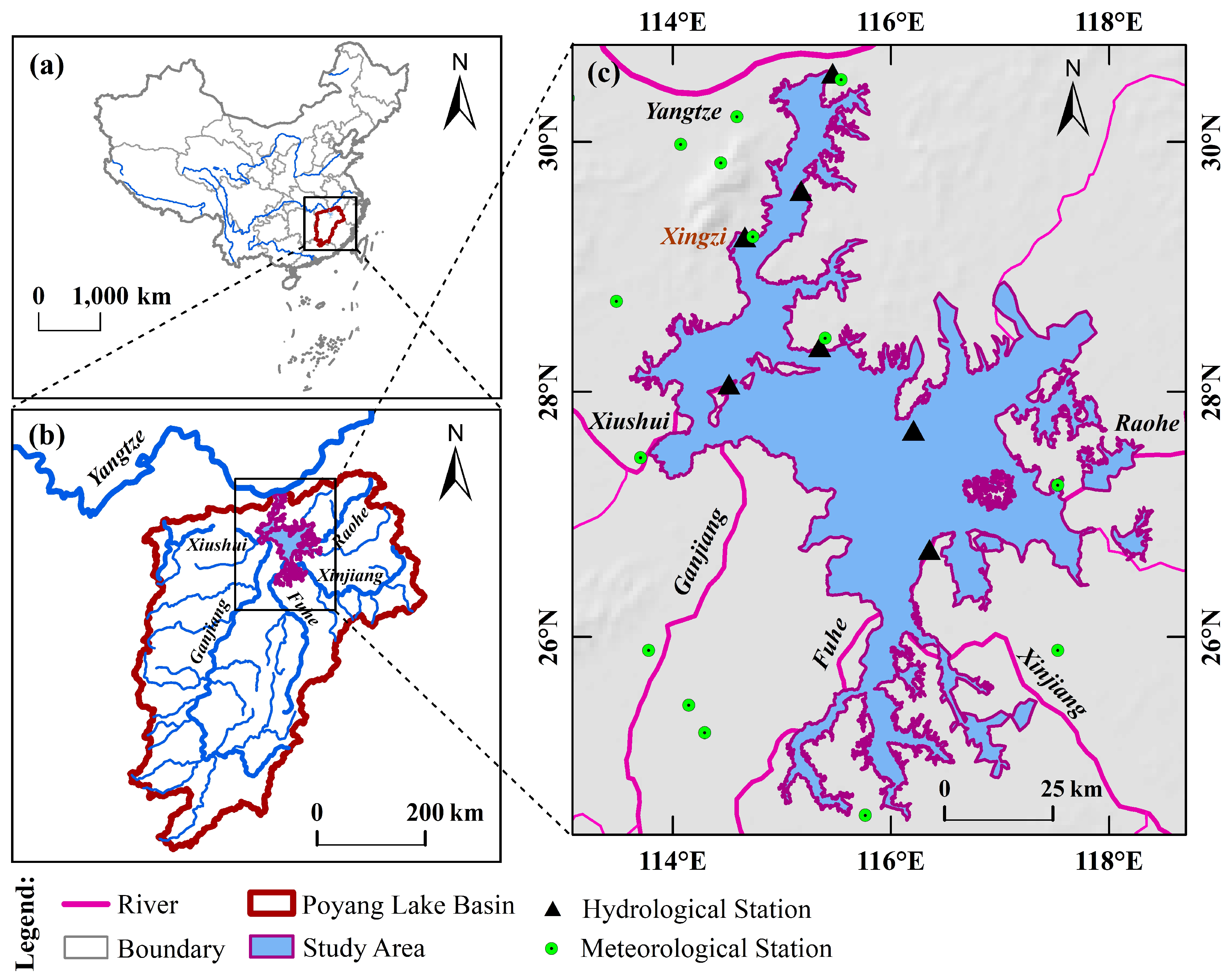
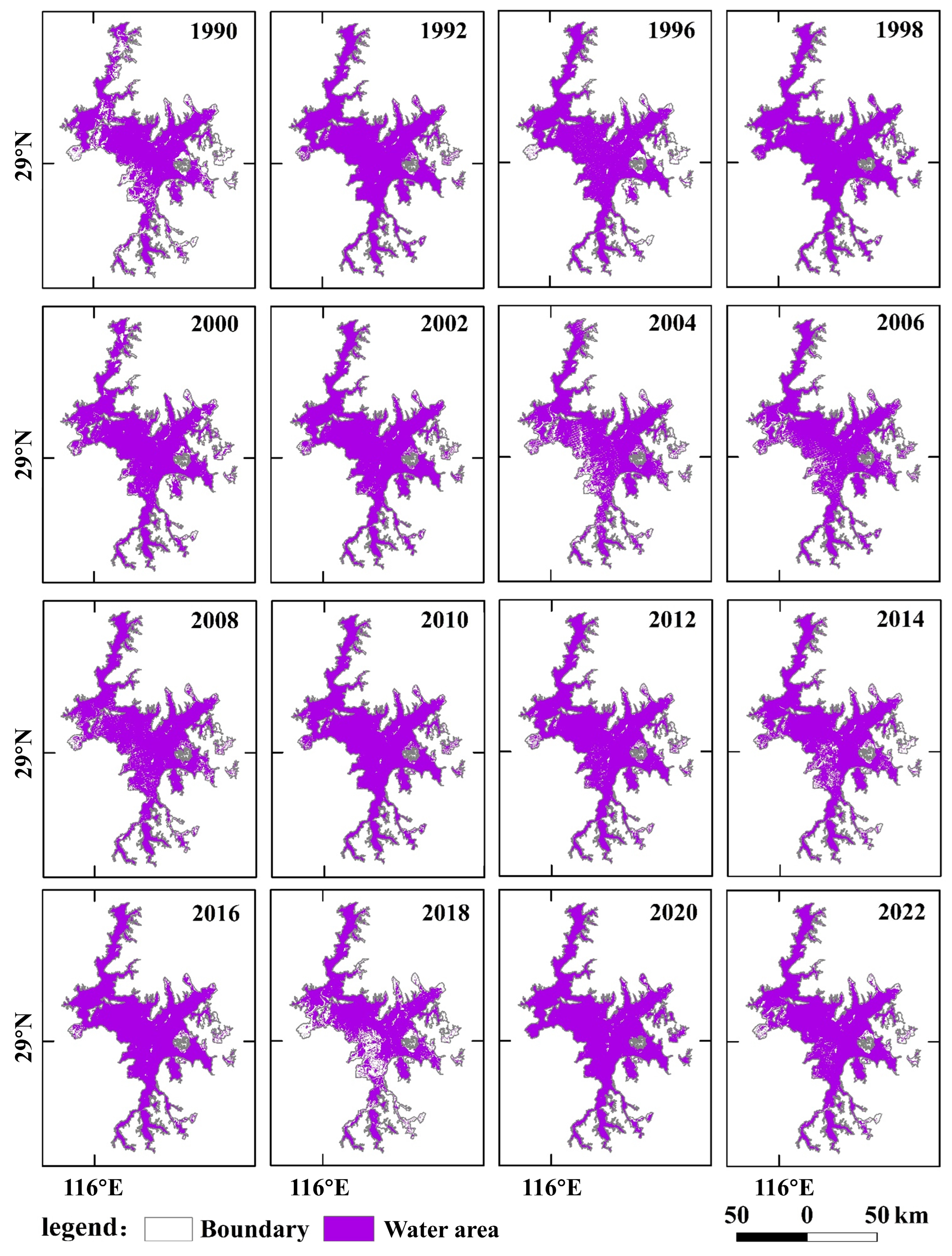
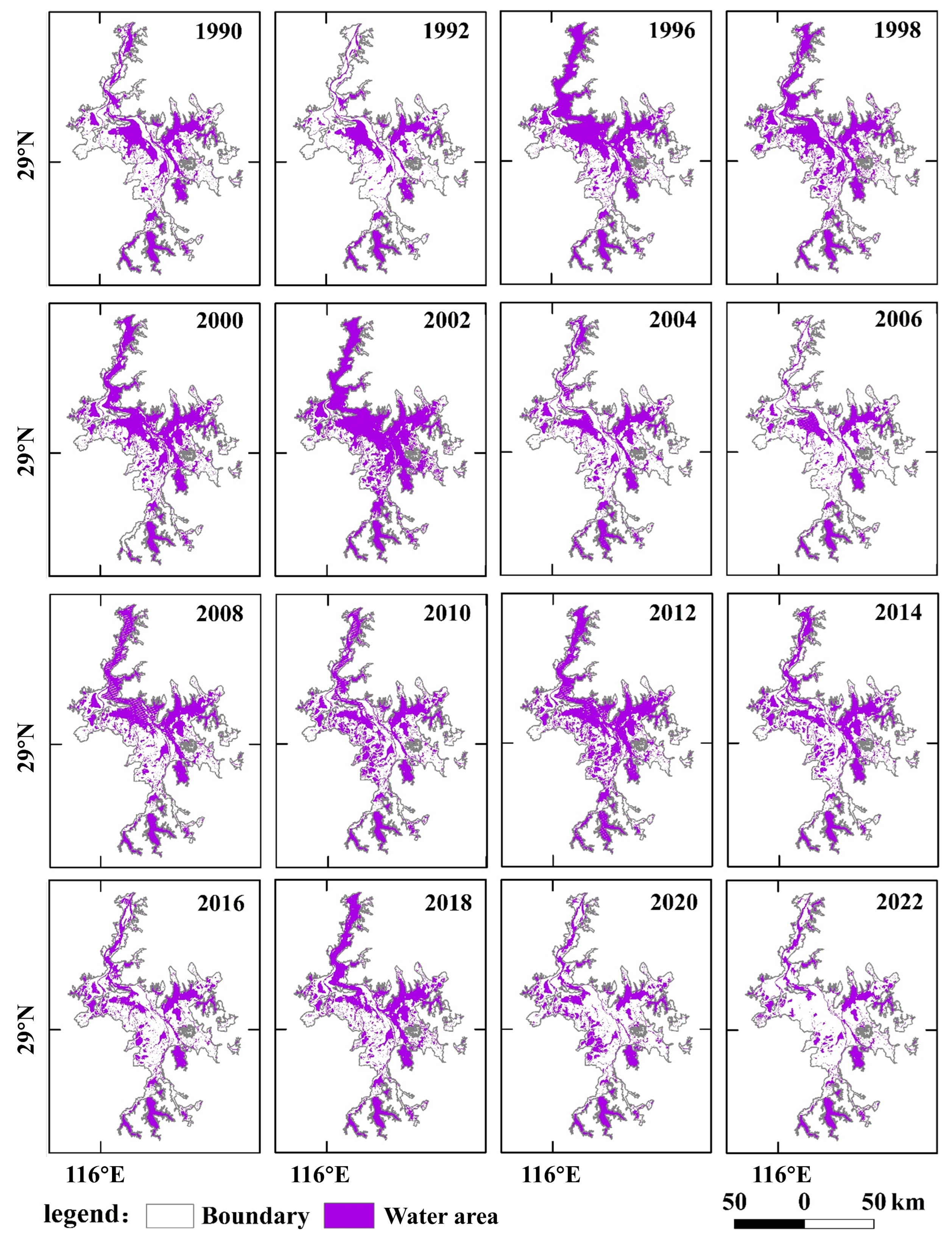
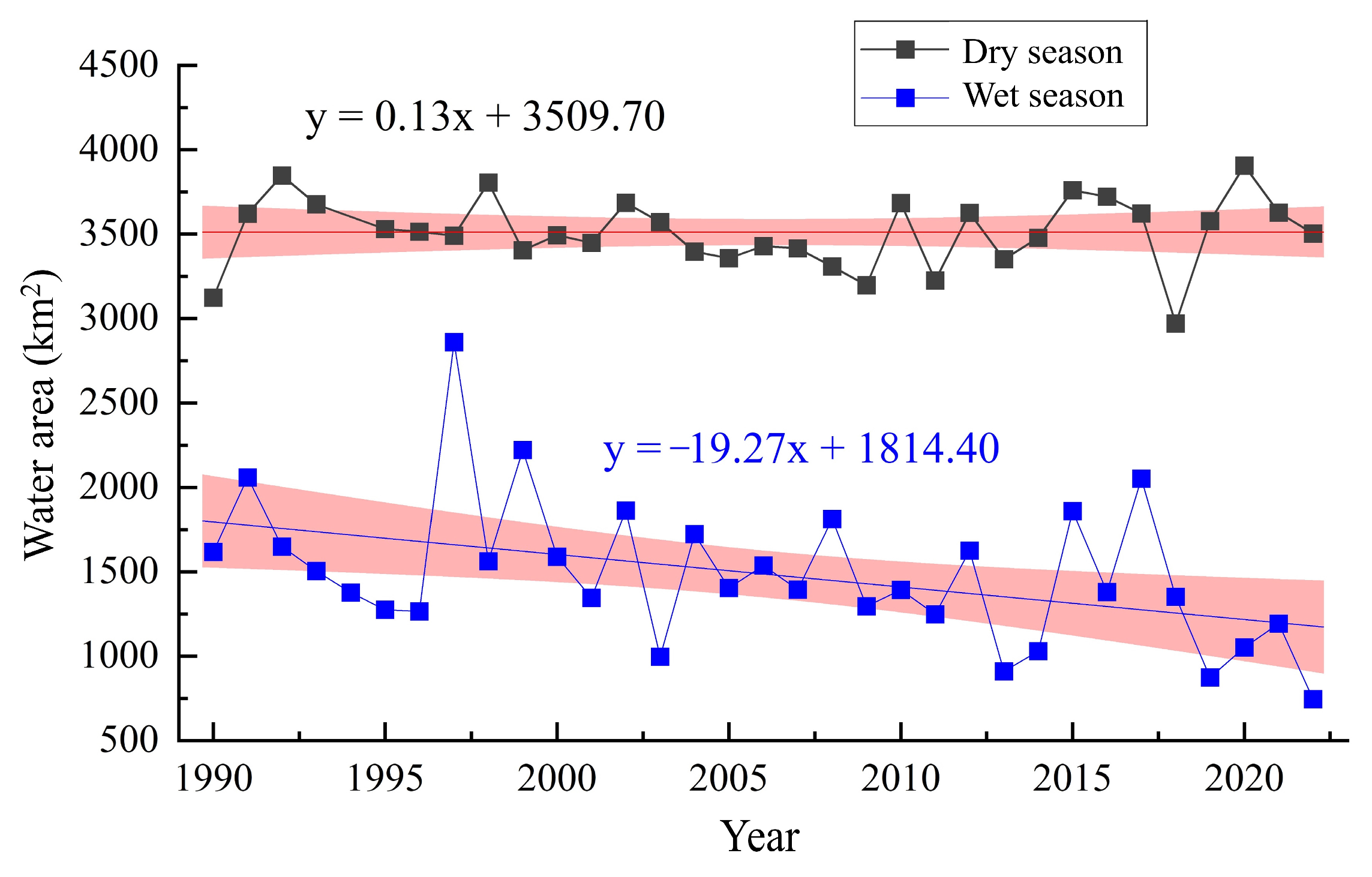





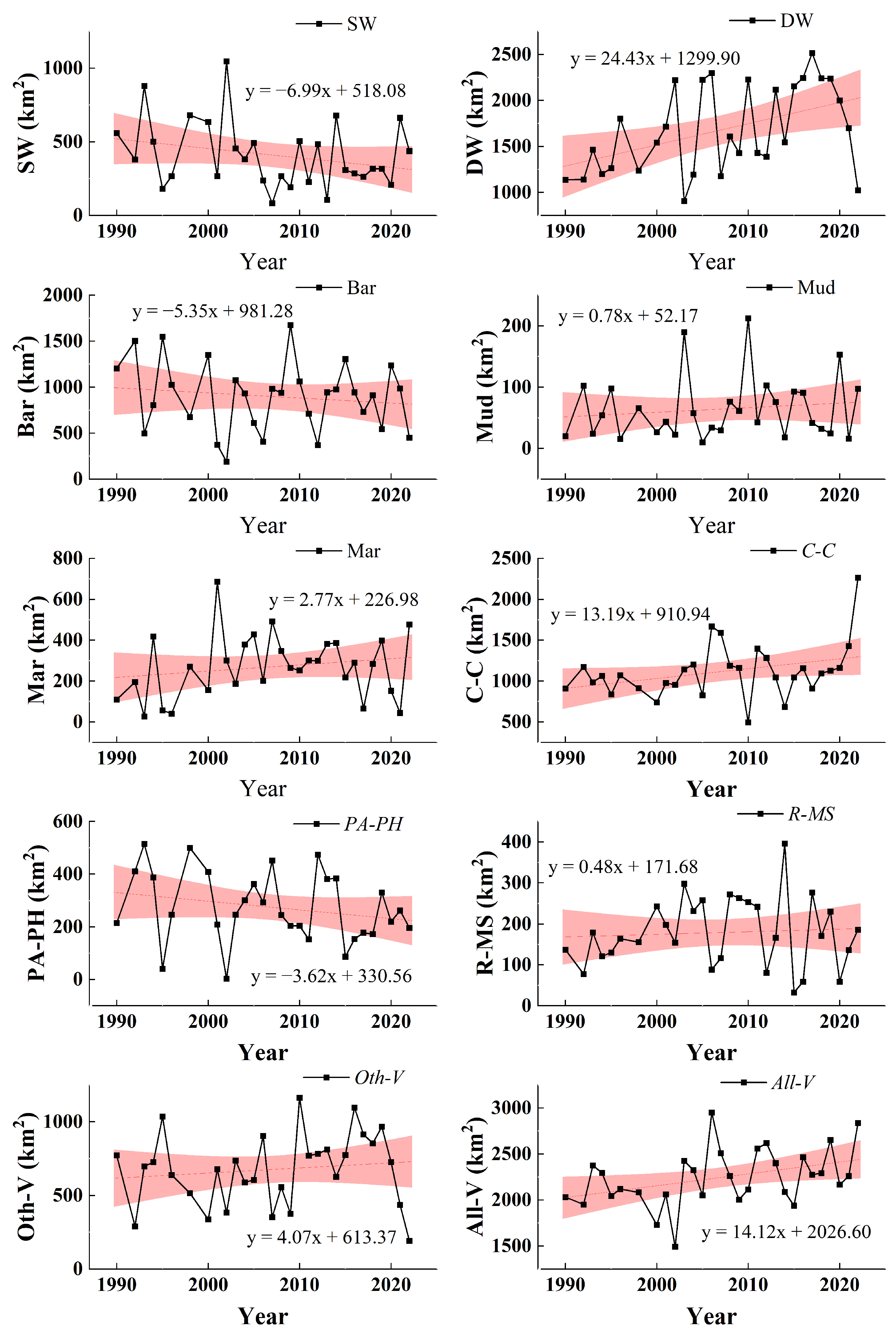


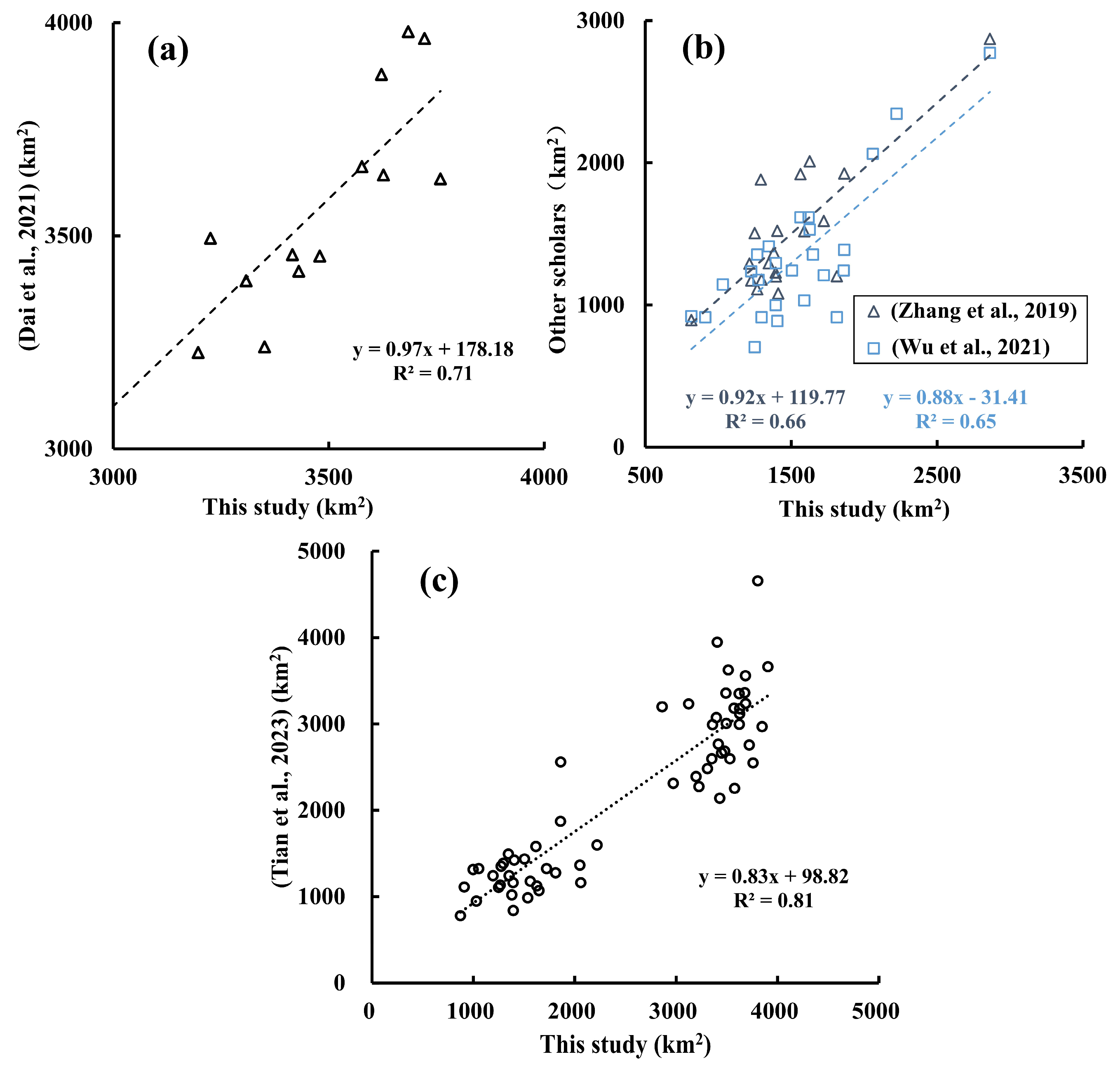
| Name | Year | Month | Resolution |
|---|---|---|---|
| Landsat 5 Collection2 Surface Reflectance | 1990~2012 | June to August (wet season); October to March (dry season) | 30 m |
| Landsat 8 Collection2 Surface Reflectance | 2013~2022 |
Disclaimer/Publisher’s Note: The statements, opinions and data contained in all publications are solely those of the individual author(s) and contributor(s) and not of MDPI and/or the editor(s). MDPI and/or the editor(s) disclaim responsibility for any injury to people or property resulting from any ideas, methods, instructions or products referred to in the content. |
© 2025 by the authors. Licensee MDPI, Basel, Switzerland. This article is an open access article distributed under the terms and conditions of the Creative Commons Attribution (CC BY) license (https://creativecommons.org/licenses/by/4.0/).
Share and Cite
Zhen, H.; Tang, C.; Zhang, S.; Wang, H.; Wu, C.; Sun, J.; Liu, W. Exploring the Vegetation Changes in Poyang Lake Wetlands: Succession and Key Drivers over Past 30 Years. Remote Sens. 2025, 17, 1370. https://doi.org/10.3390/rs17081370
Zhen H, Tang C, Zhang S, Wang H, Wu C, Sun J, Liu W. Exploring the Vegetation Changes in Poyang Lake Wetlands: Succession and Key Drivers over Past 30 Years. Remote Sensing. 2025; 17(8):1370. https://doi.org/10.3390/rs17081370
Chicago/Turabian StyleZhen, Haobei, Caihong Tang, Shanghong Zhang, Hao Wang, Chuansen Wu, Jiwan Sun, and Wen Liu. 2025. "Exploring the Vegetation Changes in Poyang Lake Wetlands: Succession and Key Drivers over Past 30 Years" Remote Sensing 17, no. 8: 1370. https://doi.org/10.3390/rs17081370
APA StyleZhen, H., Tang, C., Zhang, S., Wang, H., Wu, C., Sun, J., & Liu, W. (2025). Exploring the Vegetation Changes in Poyang Lake Wetlands: Succession and Key Drivers over Past 30 Years. Remote Sensing, 17(8), 1370. https://doi.org/10.3390/rs17081370









